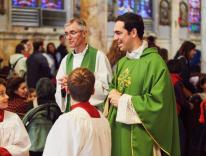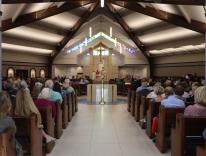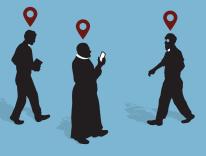With a huge Cheshire-cat smile on her face, Joan pressed the white envelope into my hand right after Mass. The word “confidential” was written next to my name. I was puzzled.
“Open it later,” she said, with that grin that wouldn’t quit.
When I did, I understood both her delight and her discretion. The mystery envelope contained an invitation to Joan’s wedding reception, an invitation unlike any of the hundreds I’ve received over the years. The invitation was to the reception only, not the wedding itself; yet far from being insulted, as a Catholic priest I was grateful for that sensitivity. I was moved, in fact, that the couple wanted me there at all. For Joan, a regular and active parishioner, was marrying her long-time partner, Jane—and as we all know, though some states now recognize these unions, the church does not.
In the weeks leading up to the event, Joan filled me in on the details. The ceremony would take place in a nearby park, presided over by an Episcopal priest who was a friend of her partner’s; a reception would follow in their backyard, with just family and a few close friends present. Dress, Joan said, was casual. With some nervousness in her voice, she asked if I could “say the grace” at the reception. I told her that as far as I knew, no canon law prohibited me from blessing lesbian party food, so I would be honored.
Although Joan didn’t know it, her invitation and request took me back many years, to another parish where I once served as an associate. Walking out the door one Sunday afternoon, dressed in black suit and Roman collar, I was accosted by the pastor, who remarked that he hoped I wasn’t going to the Smith wedding dressed like that. Sue Smith was being married—in a civil ceremony, because the gentleman she was marrying had divorced without benefit of annulment. The Smith family, close to the priests of the parish, had invited us to come to the reception. “If you wear a Roman collar,” the pastor informed me, “you’ll be affirming a union that we cannot support. That’s why I’m not going, and neither should you. But if you do go, you shouldn’t wear it.”
His conviction was so strong, and my experience so thin, that I went back inside and changed into a shirt and tie. As soon as I walked into the reception an hour and a half later, however, I realized my mistake. From the uncomfortable glances, I understood that a priest in shirt and tie screamed out a harsher judgment than a Roman collar ever could. Years later, I still regretted not following my instincts that day.
This time my instincts were clear. Since Joan and Jane’s guests didn’t know I was a priest, I went to the party dressed in golf shirt and khakis; and it felt good to mingle and blend anonymously with the crowd who wished them well. It was quickly apparent how much this couple was loved by family, friends, and neighbors. Eventually the wedding couple called me to the front, along with the Episcopal priest who’d married them. Joan and Jane spoke about God and the importance of following the directional signals that God bestows throughout our lives. Then they introduced me as the Catholic pastor of Joan’s church. I offered a grace that asked for God’s blessing, and not merely on the roast beef—though I stopped short of vowing the couple into eternity.
But only after I had finished leading the prayer did the real grace begin. Now identified as a priest, I found that people had things to say to me. Many were a bit shocked to find me there, but pleased to think Jane’s parish was an important source of support. Some asked where our church was located. One man, a Methodist minister, lamented that his church, like mine, refused to bless same-sex unions; he cordially suggested further discussion over lunch sometime. A few long-ago-drifted-away Catholics asked how they might start to drift back again. It amazed me, how little it took for people to open up and talk about their concerns, and how much they wanted to be heard and listened to; I wondered whether these simple exchanges might be the very beginnings of some deep healing.
In life and ministry, intuitively following the direction of the Spirit sometimes means coloring a little bit outside the lines. But the results are usually worth it. Though some lines are perhaps best left uncrossed for now, compassion applied creatively might help change that in the future. If it does, someday parish priests will have a lot more choice in what to wear to weddings.
Please email comments to [email protected] and join the conversation on our Facebook page.
Share
Previous Story
Prophet of the Particular
Next Story
Unabridged


